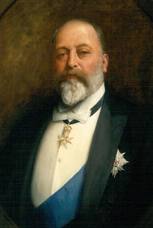When talking with people about the Edwardian Era, I'm often asked the question; What's the difference between the Edwardian Era and the Victorian Era? Well first we have to get one thing straight. While an era describes the years named after certain person(s) of note, or an achievement/movement during a time in history, it's important to remember that both the Victorian and Edwardian Era's cannot be set to a strict standard of years. This is really true of any period in history with that we label an "era" because what the word is really meant to describe is the spirit of the time. The years of 1837-1901, the beginning and end of the reign of Queen Victoria, are generally thought of as the Victorian Era, but philosophy, culture, religion, and scientific achievements of the predeceasing years may also be fitting of what we think about an era, and therefore we may include those few years before Queen Victoria's reign into what we perceive as Victorian Era as well. The years 1901-1910 are generally thought of as the Edwardian Era, named after Edward VII, but the spirit of the time transcends certainly to his successor, George V. Despite the last 6 years or so of Queen Victoria's reign being technically "Victorian", these last 6 + years have a distinctly "Edwardian" feel. Perhaps because Victoria was less and less in the public eye, and her son and heir began to have an impact on society. It is also notable that the Great War is generally thought to fit into the Edwardian Era.
So the difference between the Victorian Era and the Edwardian Era in its strictest meaning, is that the Victorian Era was the time in which Victoria was on the throne (1837-1901) and the Edwardian Era was the time in which her son, Edward VII was on the throne (1901-1910). But as history tells us, the spirit of the age is what defines an era, not just the monarch. There are some things that both eras have in common, but there are some major differences. The Edwardian Era was different in its morals, having a more lax standard in its code of conduct, compared to Victorian society, which was incredibly conservative. Furthermore, the Edwardian Era is when we start to see more and more implementation of the standard inventions used in our modern world today. By the late 1890's it became more common for homes of the middle to upper class to have electricity, phones, indoor plumbing, and even a car. These are but just a few examples of course, but the Edwardian Era is one of the finest examples in modern history of an era truly in the crux of two very different worlds.
So the difference between the Victorian Era and the Edwardian Era in its strictest meaning, is that the Victorian Era was the time in which Victoria was on the throne (1837-1901) and the Edwardian Era was the time in which her son, Edward VII was on the throne (1901-1910). But as history tells us, the spirit of the age is what defines an era, not just the monarch. There are some things that both eras have in common, but there are some major differences. The Edwardian Era was different in its morals, having a more lax standard in its code of conduct, compared to Victorian society, which was incredibly conservative. Furthermore, the Edwardian Era is when we start to see more and more implementation of the standard inventions used in our modern world today. By the late 1890's it became more common for homes of the middle to upper class to have electricity, phones, indoor plumbing, and even a car. These are but just a few examples of course, but the Edwardian Era is one of the finest examples in modern history of an era truly in the crux of two very different worlds.

